Customer service isn’t getting easier. It’s becoming increasingly difficult to keep up with. Support volumes are up, and customers expect instant, personal help. With demand continuing to climb, 78% of customers feel that support is rushed.
If you’re running any sort of employee operation that provides customer service, you know the pressure firsthand. Tickets pile up while headcount stays fixed, because your team can only stretch so far. While AI feels like the obvious next step, many examples of AI in customer service seem to risk quality.
Here is how Aloa can help. We translate AI ambition into working solutions for mid-market teams. We design custom builds that fit your tools and compliance needs, then stand up pilots in 2 to 6 weeks. Artificial intelligence handles routine questions and customer data work, so your agents focus on complex issues and high-value conversations.
This guide gives you what you can use today: 12 practical use cases with step-by-step rollouts, stack fit notes, and peer benchmarks. You will also get a clear roadmap from assessment to implementation.
Let’s dive in!
Understanding AI's Role in Modern Customer Service
Examples of AI in customer service show AI shifting support from reacting after a problem to spotting it early. It listens to customer conversations in real time, reads customer sentiment, and gets ahead of issues before they escalate.
For a mid-market team, that translates to fewer repetitive tickets, faster replies, and steadier CSAT. With natural language processing and language models, you can scale service quality and deliver relevant responses without adding headcount.
The Business Impact Reality
When you’re juggling rising ticket volume and tight budgets, you don’t want theory; you want proof. Here’s what peers are seeing:
- Healthcare under pressure: One U.S. provider rolled out AI routing and sentiment. They saved $11M a year while immediately improving CSAT, even during open enrollment crunch time.
- Banking on speed: Bradesco’s virtual agent answers over 280K questions a month with ~95% accuracy. Some responses dropped from 10 minutes to just seconds.
- Cross-industry lift: McKinsey reports companies that invest in AI-driven customer journeys see 10–15% revenue growth and 15–20% lower cost to serve, all while boosting satisfaction by 20–30%.
How that plays out for you:
- Start by targeting a 5–10% drop in handle time on repetitive intents.
- Set a seconds-not-minutes goal for FAQs through a virtual agent front end.
- Track CSAT and deflection by intent so improvements show up clearly in your reports.
Debunking the Replacement Myth
Your agents might be wondering, “Does AI mean fewer of us?” While it’s understandable to fear, a study of nearly 5,000 support agents showed AI assistance in customer support boosted productivity by ~14%, especially for newer reps.
More studies like this are forthcoming. Essentially, AI wasn’t replacing them; it was making them faster.
The best way to frame it is this:
- AI handles the boring stuff: FAQs, data lookups, form-filling, summaries, etc.
- People own the high-value work: empathy, escalations, and the conversations that build trust.
TL;DR, if your team’s work can be replaced by AI, it’s a sign that you can accomplish a whole lot more. You’re shouldering the opportunity cost of having your team handle highly repetitive tasks, when they can be trained to use AI and complete tasks at a higher quality and faster pace.
If you roll out AI solutions with guardrails (clean handoffs, early human-in-the-loop checks, and CSAT tracking per intent), agents will see it as a tool, not a threat. And if you need help designing those safeguards, our AI consulting team has assisted mid-market leaders in your exact position.
Integration Capabilities with Existing Systems
The other question you might have is, “Do I need to rebuild my systems for this?” Short answer: not always.
Here’s the playbook we’d recommend:
- Start where you are: Salesforce, Zendesk, HubSpot, Freshdesk; most already have connectors.
- Pilot fast: 2–6 weeks is enough to map out your high-volume intents (billing, returns, order status, password resets, scheduling) and launch a minimum viable product.
- Ground answers in your content: Retrieval-augmented generation ties every AI response to your own knowledge base, so accuracy stays tight and brand-safe.
- Automate follow-through: Link AI to CRM or ticketing with workflow automation so agents don’t spend time re-entering data.
- Baseline first: Capture CSAT, first response time, deflection, and cost per interaction now, so after launch you’ve got before-and-after proof.
That’s exactly how the healthcare provider hit savings and satisfaction gains without touching their existing stack. AI didn’t require a rebuild if it’s done strategically.
12 Proven AI Customer Service Examples
AI in customer service has moved beyond the hype stage. Mid-sized teams are already cutting handle times, reducing costs, and raising CSAT with tools they could deploy in weeks, not years. Below, you’ll find twelve examples you can borrow directly: what they are, how peers rolled them out, the results they measured, and how to scale them in your own operation.
1. AI Agents (Smarter Than Old Chatbots)
The days of “press 1 for billing” are over. Modern virtual assistants hold natural conversations, pull answers from your knowledge base, and hand off cleanly when needed.
Here’s how this shows up in mid-sized teams:
.webp)
- A gaming company wired Zendesk AI into its helpdesk, deflected 8,000 tickets, and saved $1.3M in year one.
- Mature deployments resolve up to 80% of routine tickets, so agents focus on complex issues.
Launch in weeks with a tight, low-risk sequence:
- Connect the agent to Zendesk, Freshdesk, or Salesforce.
- Train on 10–15 common questions first: returns, billing, account access, order status.
Run the numbers before kickoff:
- Expect $0.50–$0.70 per bot conversation versus about $19.50 per agent hour.
- With 50,000 annual tickets, even 20–30% deflection typically yields six-figure savings.
Expand impact once chat is steady:
- Reuse the same agent for email and social without a rebuild.
- Add languages, secure actions, and deeper workflows over time. For custom multi-channel rollouts, Aloa can plug this into your stack with minimal lift.
2. Voice AI and Intelligent IVR Systems
Old phone trees slow customers down. Conversational AI understands human language, detects intent, and routes correctly on the first try.
Here’s what this looks like on phones:

- Bank of America’s “Erica” handles over 2 million customer interactions daily, guiding callers without rigid menus.
- Providers like AT&T use intent recognition from natural language to reduce misroutes and speed resolution.
Stand up a voice pilot in weeks:
- Map your top ten reasons for calling and script sample utterances.
- Connect to your IVR, helpdesk, and CRM; define clean human handoffs.
What the budget looks like:
- Most platforms bill per minute. Shaving 30–60 seconds per call frees hundreds of hours each quarter.
- Track abandon rate, faster response times, and CSAT on voice.
How to grow it after the pilot:
- Add languages and secure actions (payments, plan changes).
- Tie actions to downstream systems with workflow automation.
3. Proactive Customer Support
Waiting for tickets invites backlog. Proactive support uses product, logistics, and billing signals to reach customers before they contact you.
Where this shows up:
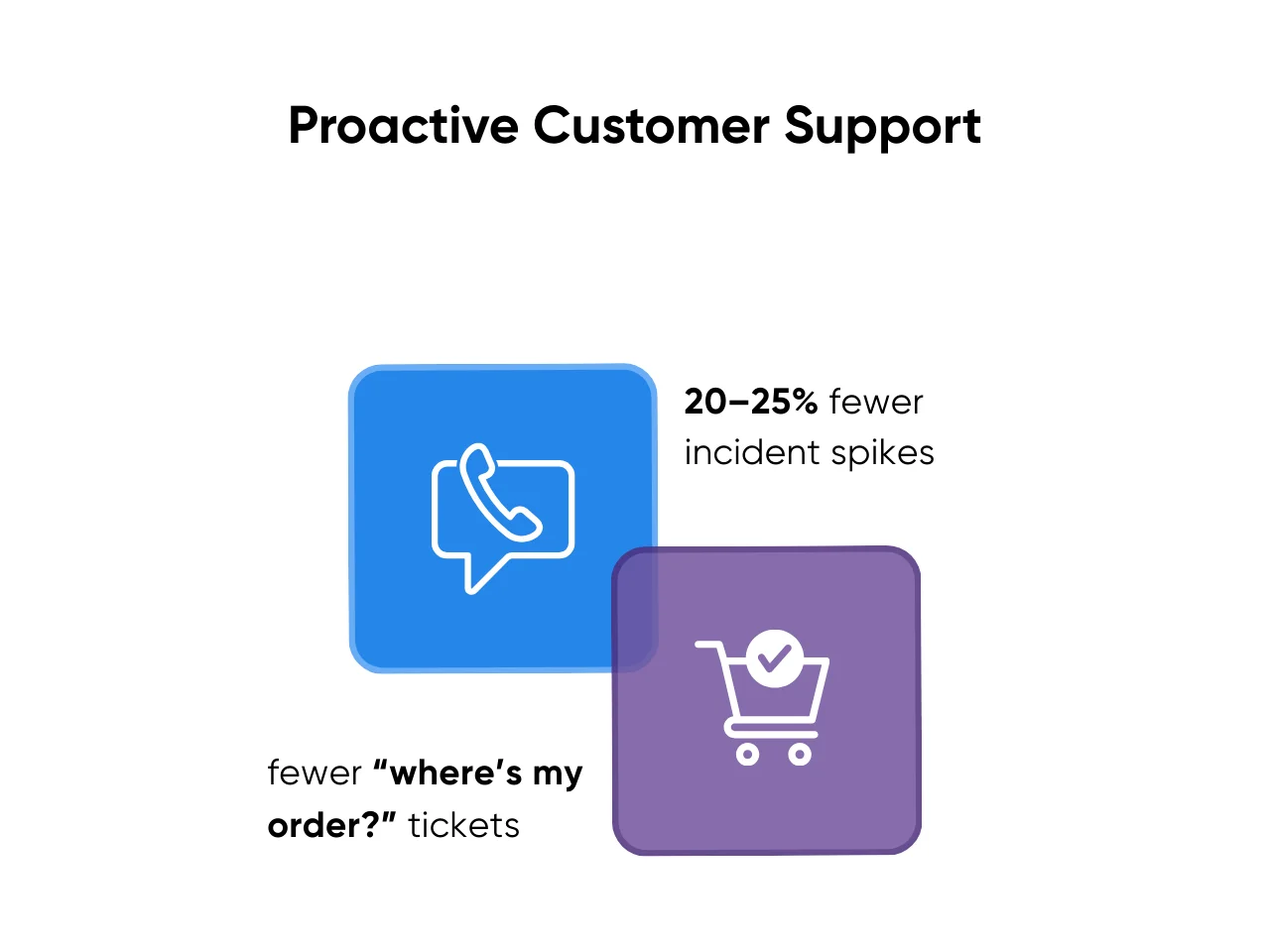
- Delivery exceptions trigger “new ETA” alerts that cut “where’s my order?” contacts.
- Outage notices with live restoration ETAs reduce incident spikes by 20–25%.
Stand up without heavy lifting:
- Pipe events into your messaging tool; define triggers like “late scan >24h” or “renewal in 14 days.”
- Orchestrate email, SMS, and in-app updates with clear opt-outs.
What the budget tends to look like:
- Upfront integration plus messaging fees; savings show as avoided contacts.
- Many teams avoid seasonal hires once alerts are live.
How you scale once it works:
- Expand to billing anomalies, expiring cards, and returns.
- Personalize with usage and tenure; power predictions with AI and machine learning.
4. Real-Time Agent Assistance (Copilot Systems)
Copilots sit in your helpdesk and coach in the flow of work, like drafting replies, summarizing threads, and surfacing the right KB snippet.
What shows up on agent screens:
.webp)
- Suggested first replies tuned to context and tone.
- One-click summaries and similar past tickets to stop hunting.
Launch in days with minimal risk:
- Enable the add-on, connect your KB, and start in “approve before send.”
- Track handle time, first-contact resolution, and customer feedback by intent.
What results to expect:
- Productivity lifts around 14% as minutes drop per ticket.
- Leaders hold SLAs during spikes without temp headcount.
Where you take it next:
- Add call wrap-ups and dispositions; ground suggestions with retrieval augmented generation.
5. Automated Quality Assurance
Manual QA checks a tiny sample. AI QA scores every interaction and surfaces coaching moments you’d otherwise miss.
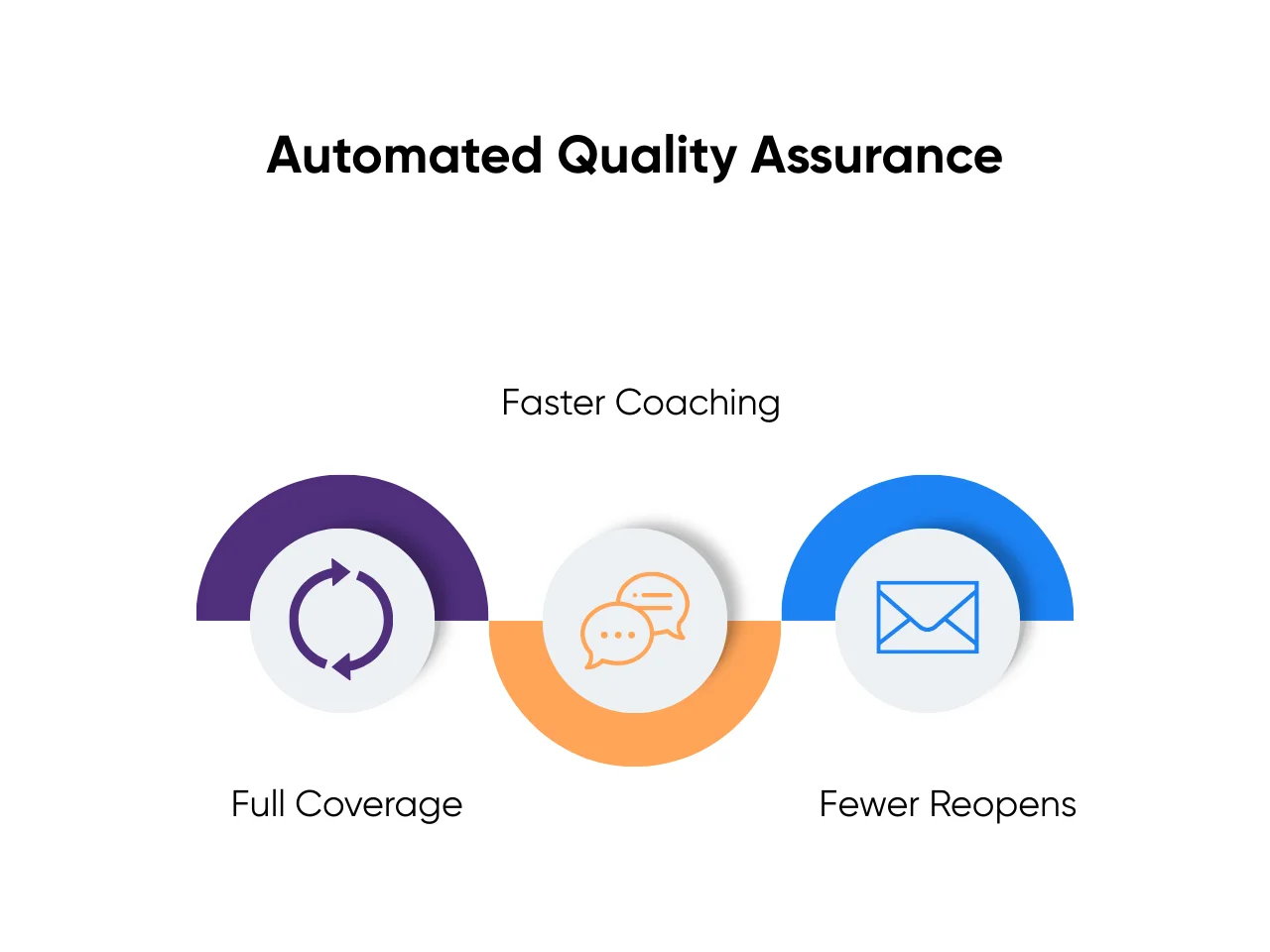
What changes on day one:
- 100% coverage across chat, email, and voice transcripts.
- Scoring for tone, accuracy, compliance, and support experience quality.
Get a pilot live in two weeks:
- Import 90 days of data, load your rubric, and run read-only scoring.
- Compare to human QA, tune thresholds, and enable alerts.
Budget view you can defend:
- Fixed license or usage beats manual sampling.
- Reallocate QA time from scoring to coaching customer support agents for faster gains.
How you scale once quality holds:
- Add multilingual scoring and real-time alerts with workflow automation.
- Leader dashboards highlight trends by agent, intent, and product.
6. Intelligent Ticket Routing and Prioritization
Manual triage slows support operations. Intelligent routing scores urgency and sends each request to the best available agent.
Where this changes your queue:
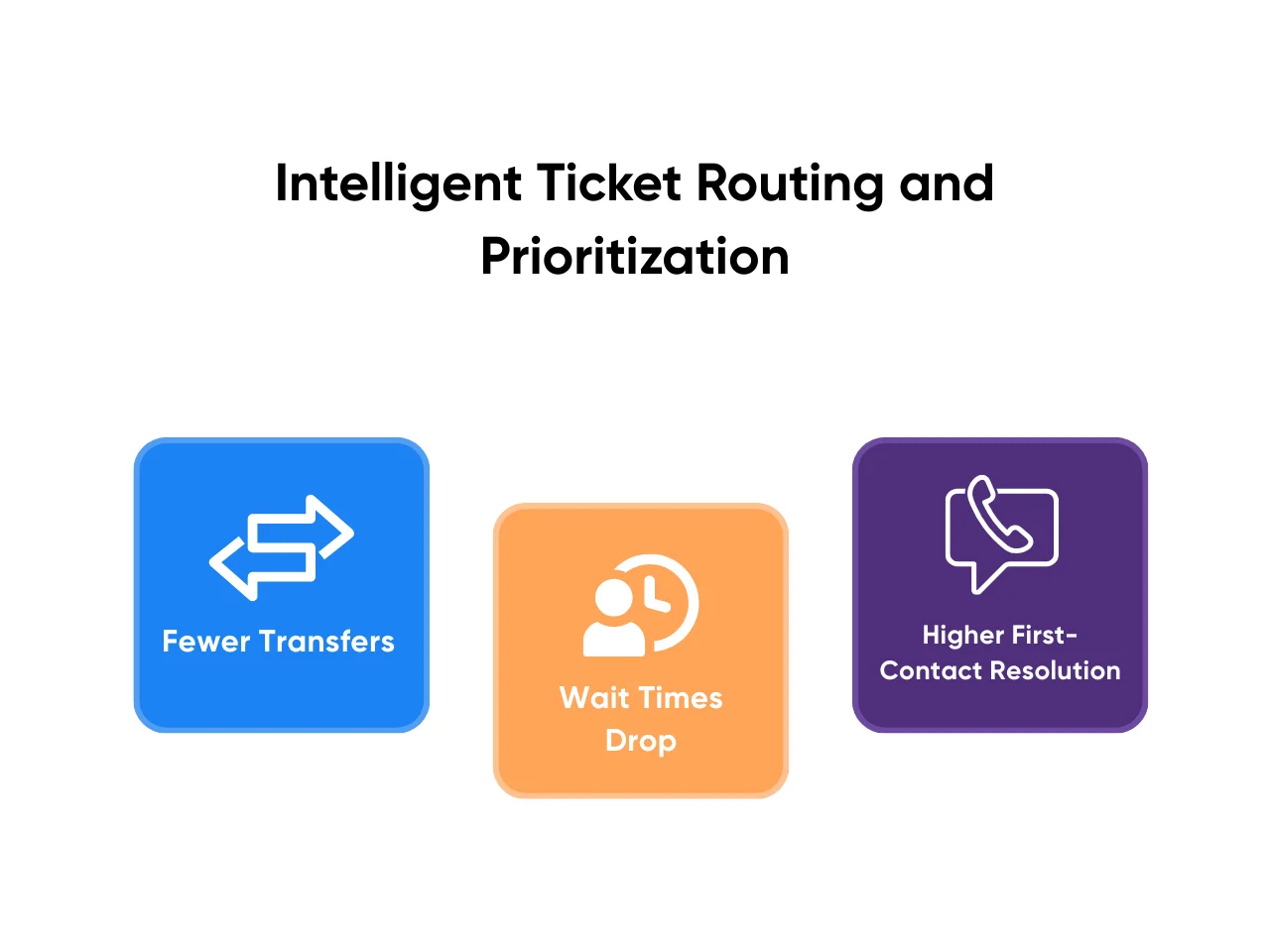
- IBM reports a 33% agent-efficiency increase when routing uses skill and context.
- Average wait time fell to ~33 seconds in one case study after intent-based routing.
- High-risk tickets jump the line automatically; routine requests head to self-serve.
Get it live without reworking your stack:
- Map customer queries to skills; connect routing to CRM and schedules.
- Add sentiment tags so frustrated customers reach seniors first.
Costs to expect and payback:
- Priced per seat or interaction; savings from fewer transfers and faster resolution.
- Use minutes saved × monthly volume × agent rate to show ROI.
How to grow once routing works:
- Add predictive urgency and load balancing across teams.
- Improve intent accuracy with natural language processing.
7. Sentiment Analysis and Emotional Intelligence
AI reads tone in text and voice, flags potential issues, and guides recovery before problems grow.
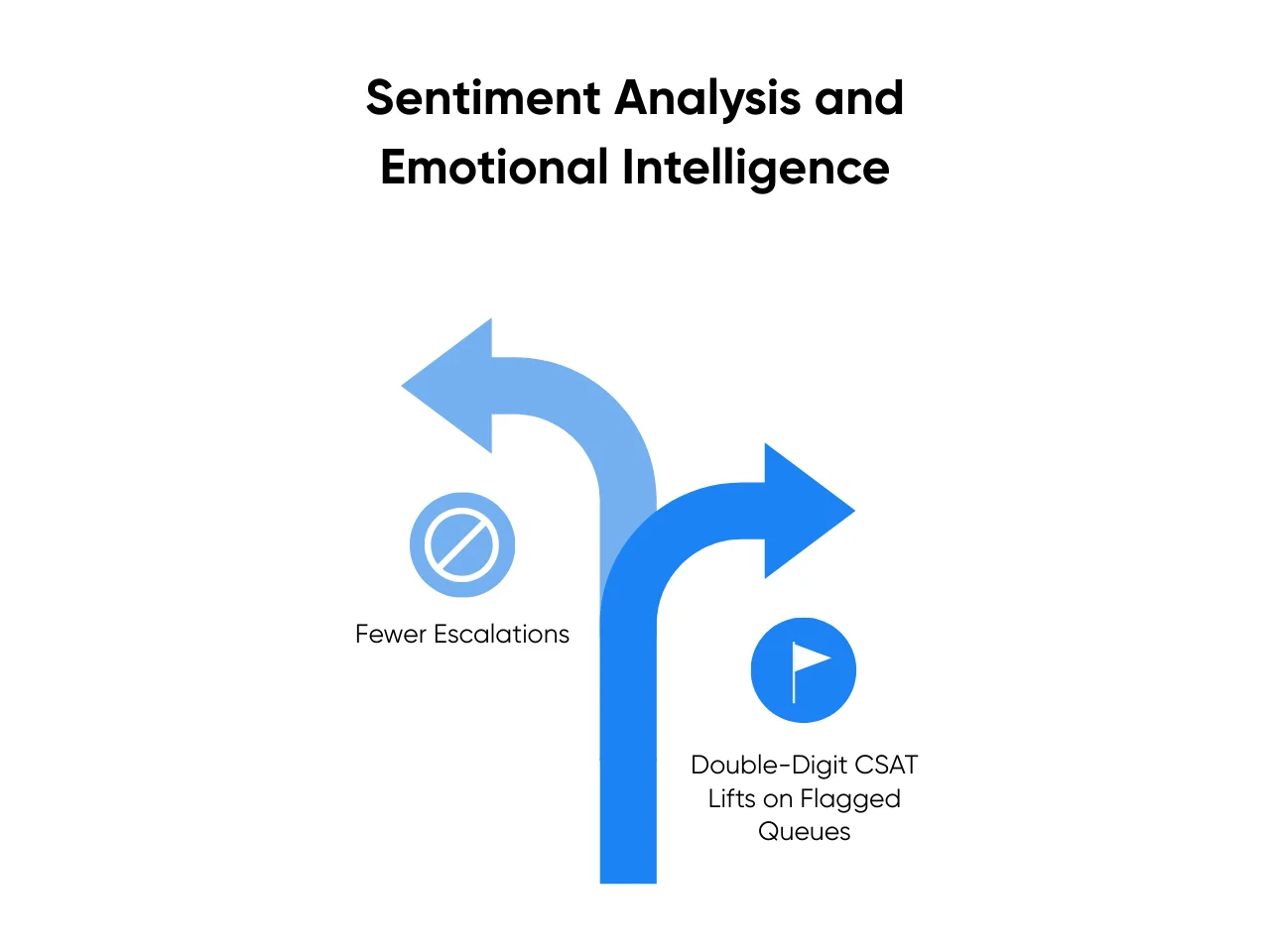
Where this pays off:
- Negative tone prompts save attempts or senior pickup.
- Emotion trends steer targeted coaching and reduce reopens.
Switch it on without heavy engineering:
- Start with text; feed chats and tickets to a sentiment service tied to your helpdesk.
- Set simple rules, like “very negative + VIP” triggers supervisor alerts.
What leaders measure to prove ROI:
- Fewer escalations and faster recovery on at-risk conversations.
- Double-digit CSAT lifts on sentiment-aware queues.
Scale it responsibly once it works:
- Extend to voice and social media; review privacy and bias settings.
- Ground replies in policy using retrieval augmented generation.
8. Multilingual Support at Scale
Global customers expect customer care in their language. AI makes that practical without a 24/7 multi-country team.
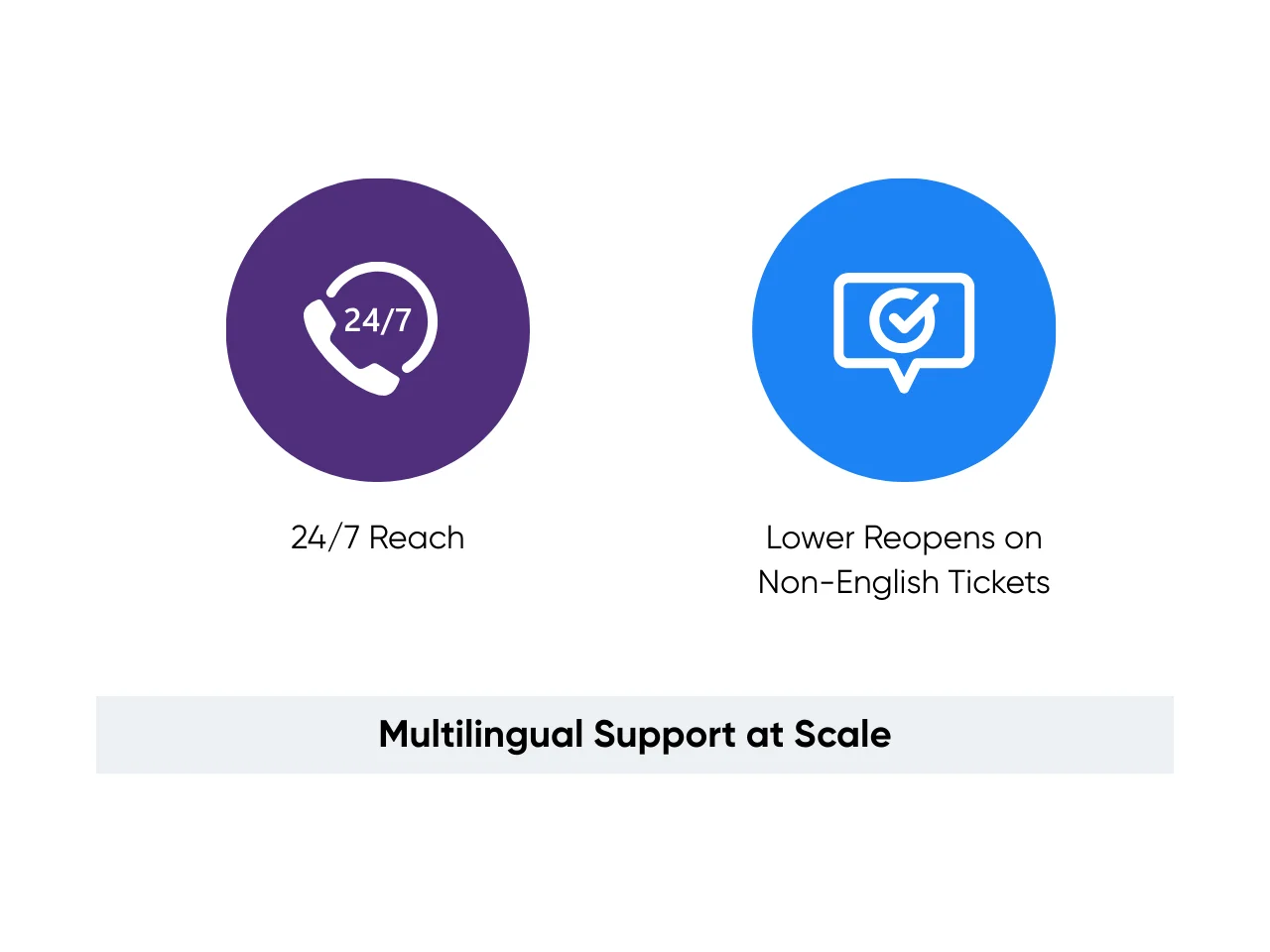
Where this changes your reach:
- Chat and email swap languages automatically with glossary control.
- Voice agents transcribe, translate, and summarize for non-English calls.
Spin this up without a global team:
- Turn on language detection; connect a translation service for your top five languages.
- Set “review required” for refunds, medical, or financial topics handled by customer service teams.
Budget talk in plain terms:
- Translation is per character or minute; far cheaper than staffing bilingual shifts.
- Track first response time, deflection, and reopens on non-English tickets.
How to grow once quality holds:
- Add languages in waves; bring voice translation online next.
- Fine-tune terminology with LLM fine tuning.
9. Self-Service Optimization
Great self-service reduces tickets without hurting quality. AI upgrades search and guides troubleshooting so customer questions get solved on their own. Nextiva reports teams have tripled their self-service rate (~206% increase) while cutting ticket volume in half, with CSAT up 9.4% after improving portals with AI.
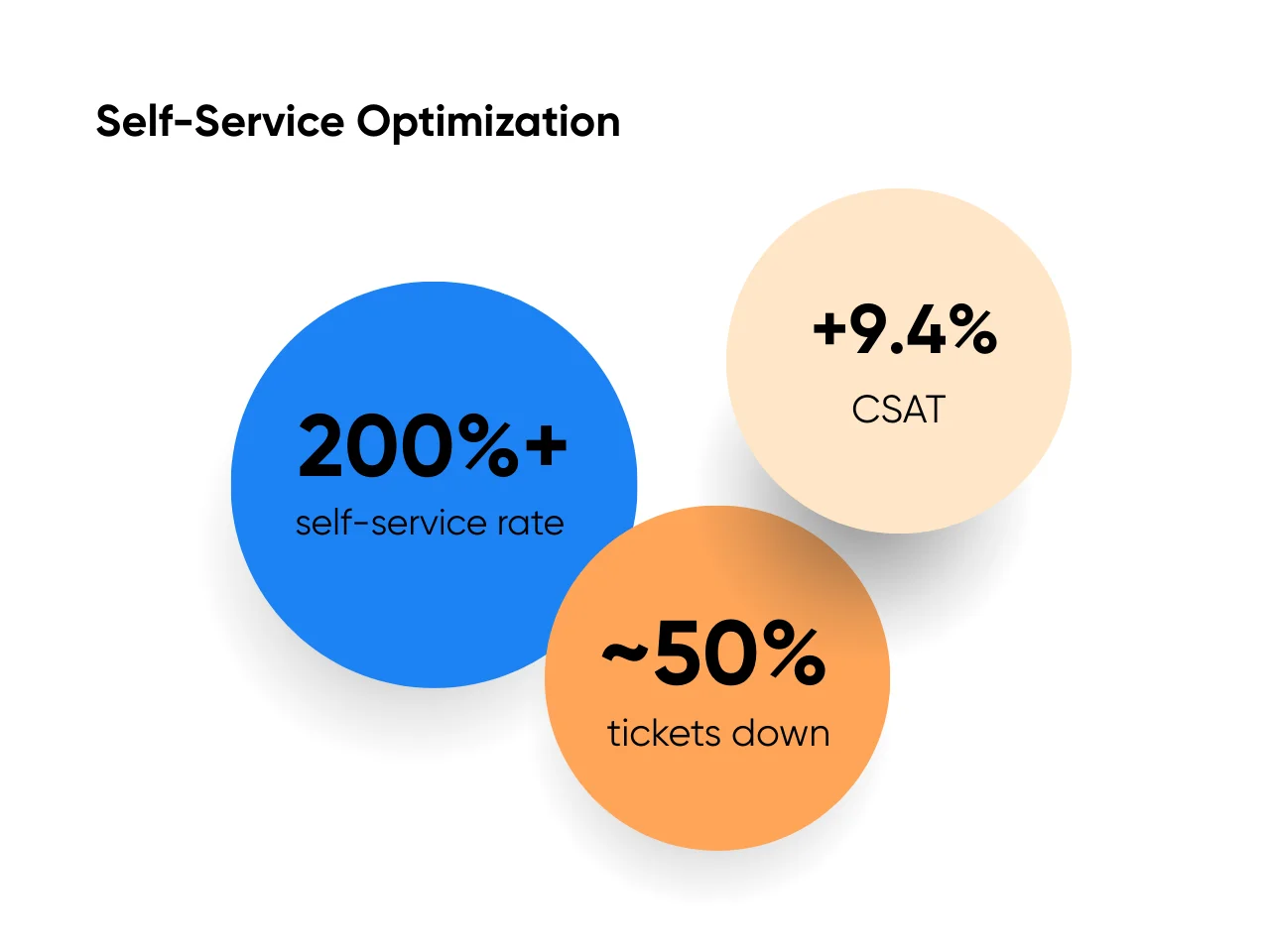
Where this improves your portal:
- Natural-language search returns the right article, not just keyword matches.
- Guided flows walk customers through fixes and log success.
Stand up in weeks without a rebuild:
- Connect your KB to a retrieval layer so answers cite approved content.
- Map the top ten tasks and add “was this helpful?” customer feedback everywhere.
What the budget looks like:
- Usage and light integration; savings show as avoided contacts.
- Many teams triple self-service and cut tickets nearly in half.
How to grow once it works:
- Add visuals and tie “couldn’t solve” to instant chat with context.
- Auto-create article requests with internal tooling.
10. Generative AI for Dynamic Responses
Static scripts slow customers down. Generative AI drafts context-aware replies in your brand voice, pulls facts from your KB, and updates tone based on sentiment. The result is fewer back-and-forth messages and faster resolutions, an AI customer service example that customers actually feel.
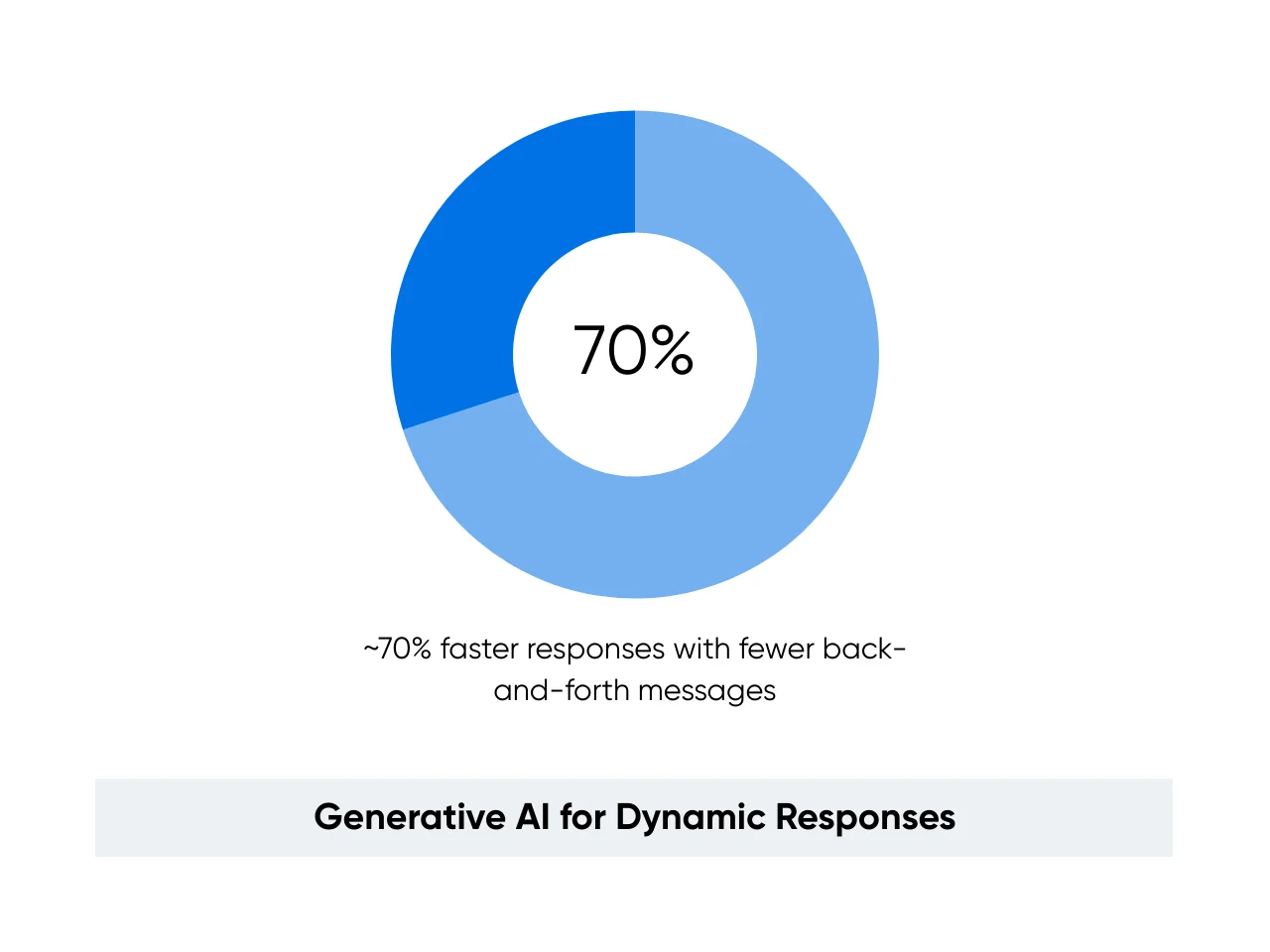
Where it moves the needle in real conversations:
- H&M used generative AI to cut response times by about 70%, while keeping answers on-brand and accurate. That’s what customers notice: fast, relevant help without sounding robotic.
- Dynamic replies reduce follow-ups on routine questions (shipping, returns, billing), so agents spend time on complex cases that need judgment.
Ship a safe pilot in weeks:
- Pick 8–12 high-volume intents; ground every answer in your KB.
- Require human approval for two weeks; keep strict escalation rules.
Budget view that passes scrutiny:
- Usage-based; control with prompt templates and caching.
- Savings show as fewer agent minutes and higher first-contact resolution.
Scale without surprises:
- Extend to email and social; tune style via generative AI.
- Pair with classifiers from natural language processing to route edge cases in your contact center.
11. AI-Powered Knowledge Management
Your KB is useful only when answers are easy to find and always current. AI turns it into a living system that drafts, flags gaps, and keeps content fresh.

Where this upgrades day-to-day work:
- Answers cite the exact article, cutting guesswork and reopens.
- Unanswered searches and escalations become prioritized content tasks.
Get it live without a rebuild:
- Enable retrieval so bots and agents pull from approved content.
- Define taxonomy (product, feature, intent, audience) and capture customer behavior signals at publish.
Costs and the proof you show:
- Savings show as fewer reopens and faster agent ramp.
- Aim for 25% fewer reopens and 30% faster time-to-answer.
How you scale once it sticks:
- Extend grounding to every channel.
- Leader dashboards track article health; archive stale content quarterly.
12. Revenue Generation Through Support
Support can be a profit center when product recommendations fit the moment. Solve the problem first, then present a relevant upgrade or add-on.
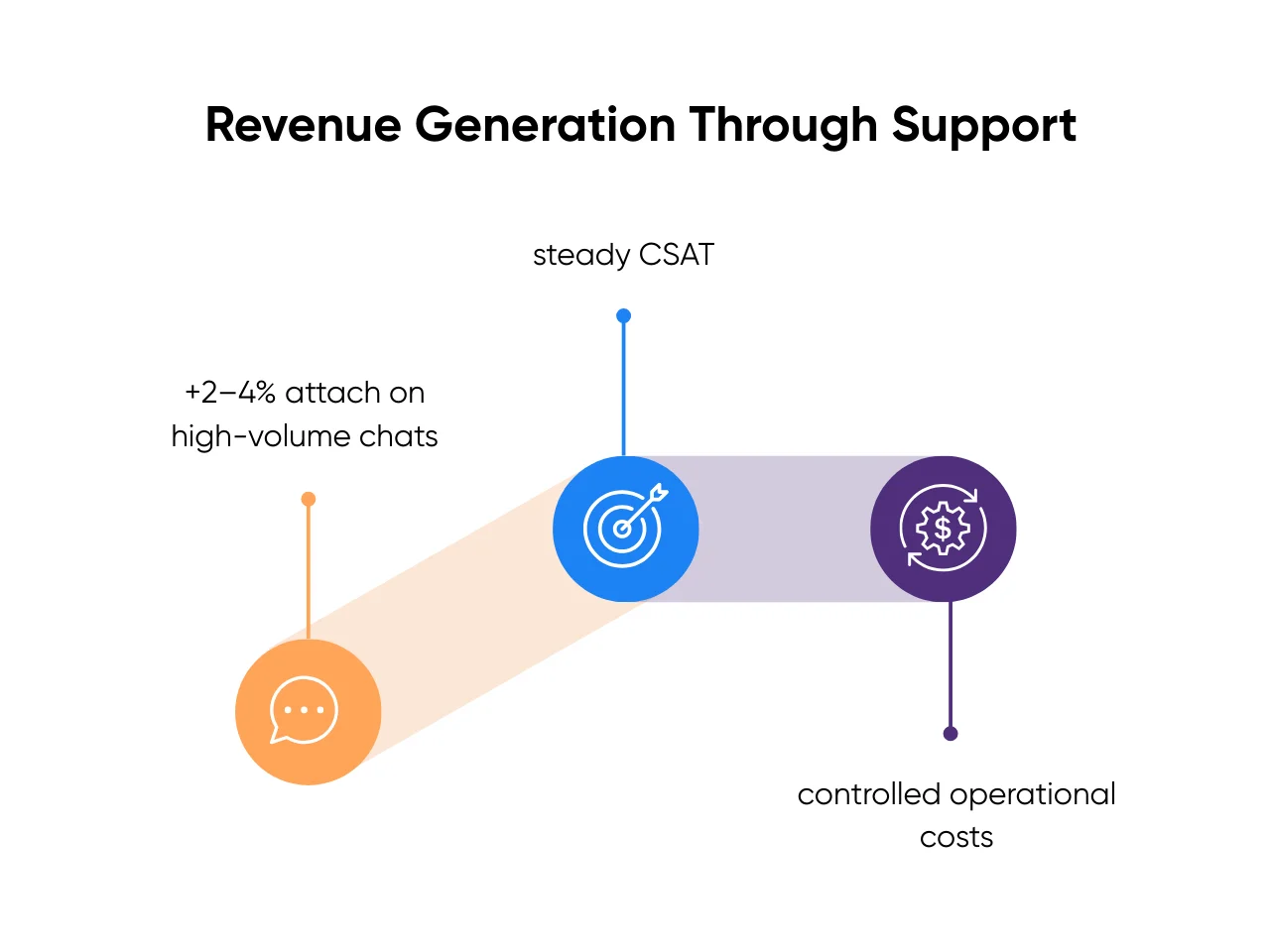
Where support earns revenue today:
- Post-resolution chats suggest in-stock exchanges or bundles.
- SaaS agents surface prorated upgrades when usage hits plan limits.
Stand up a low-risk pilot:
- Connect to catalog, pricing, and eligibility APIs; start with one journey.
- Gate offers with rules: “issue resolved,” “neutral or better sentiment,” “cap frequency.”
Budget view and targets to track:
- Measure attach rate, incremental conversion lift, AOV lift, and revenue per contact while watching operational costs.
- Even a 2–4% lift on high-volume chats can fund training and software.
Scale without hurting CX:
- Publish an offer policy and suppress on sensitive tickets.
- Automate safe handoffs with workflow automation and wire deeper hooks with existing product enhancements.
Implementation Strategies and Best Practices
Here’s a practical roadmap you can run with your current customer service operations, people, and budget. It mirrors how mid-sized teams roll out working examples of AI in customer service in 2–6 weeks, then scale with confidence:
Assessment and Planning
Start with a fast diagnostic you can finish in ten days:
- Volume and Intent Snapshot: Pull 90 days of tickets by channel, top intents, languages, and hours. Mark five repetitive intents to automate first.
- Stack and Data Check: List helpdesk, CRM, telephony, knowledge base, auth, and data owners. Note APIs, rate limits, and SSO.
- People Map: Identify a business owner, one Ops lead, one customer service agent lead, and one analyst.
- Baseline Metrics: Capture CSAT, first response time, handle time, deflection, reopens, and cost per interaction. These are your before/after anchors.
Turn that snapshot into a one-page plan:
- Pilot Ccope: Channel, five intents, guardrails, and success thresholds.
- RACI: Who decides, who builds, who reviews, who reports.
- Risks and Mitigations: Data privacy, hallucinations, bias, and fallbacks.
For vendor fit and integration help, Aloa can co-write this plan with you and align it to your stack. For a quick, plain-English walkthrough, see AI in Customer Support: 4 Implementation Steps in 2025.
Implementation Timeline
Use a tight four-phase schedule you can defend with leaders:
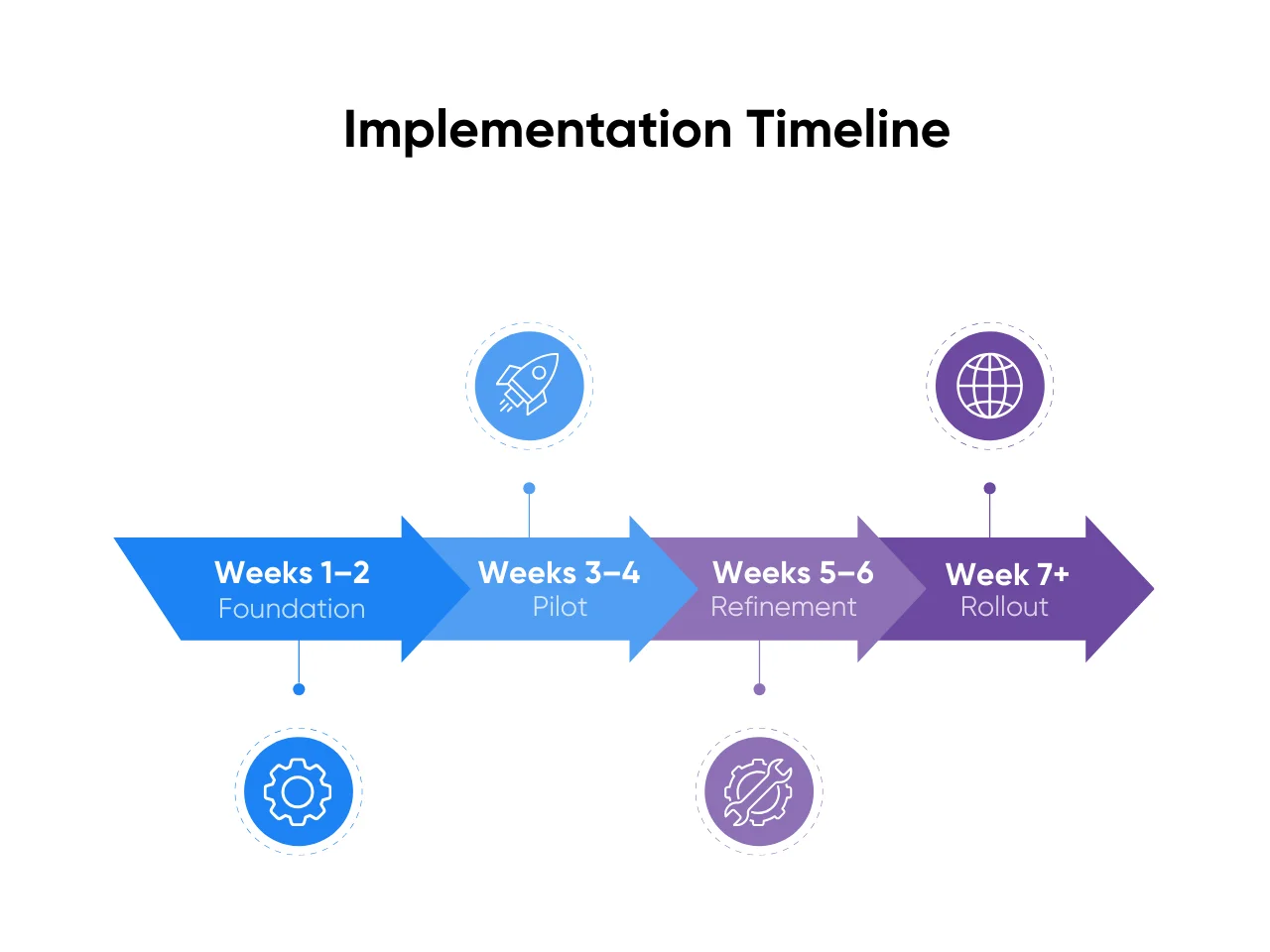
- Weeks 1–2: Foundation
- Provision sandboxes, connect the helpdesk, CRM, and knowledge base.
- Wire retrieval augmented generation so answers cite approved content.
- Draft prompts, escalation rules, and security scopes.
- Run red-team tests on sensitive intents.
- Weeks 3–4: Pilot
- Launch on one channel with five intents and human approval required.
- Track handle time, CSAT by intent, containment, and errors daily.
- Hold two calibration huddles per week with Ops and senior agents.
- Weeks 5–6: Refinement
- Promote intents that meet thresholds to auto-send.
- Expand to three more intents or add voice summaries.
- Close knowledge gaps; update articles and macros.
- Automate follow-through for refunds, tags, and CRM updates.
- Week 7+: Rollout
- Add a second channel, then multilingual support.
- Publish a living runbook: prompts, fallbacks, and evaluation steps.
- Present before/after results and next-quarter targets.
This cadence proves value early, contains risk, and builds trust with agents who see faster work and fewer clicks.
Team Training and Adoption
Adoption rises when people see how AI helps them today:
- Kickoff Narrative: “AI clears repetitive tasks so you handle tougher problems and earn higher quality scores.” Show two live examples from your queue.
- Hands-on Reps: Run 30-minute sessions where agents edit AI-drafted replies, compare them to their drafts, and save approved versions as macros.
- Guardrails Agents Trust: Approval mode for two weeks, clear handoff rules, and a visible “ask a human” path for customers.
- Coaching Loop: Weekly review of three tickets per agent: one win, one fix, one KB improvement. Promote agent-sourced prompts that lift CSAT.
Create an “AI champion” rotation:
- Champion Duties: Triage feedback, log false answers, flag new intents, and propose KB updates.
- Recognition: Track time saved and showcase champions in team huddles.
If you want structured enablement, we pair change playbooks with tool setup through digital transformation and internal tooling so your team adopts new workflows smoothly.
Budget and Procurement Essentials
Price the pilot in a way finance understands:
- Licenses and Usage: Helpdesk AI add-ons, model calls, and translation minutes.
- Implementation Effort: Light integration and prompt work. Avoid custom builds at pilot stage.
- Ops Time: Agent training, QA reviews, and weekly calibration huddles.
Use a simple calculator leaders accept:
- Saved minutes per ticket × monthly volume × fully loaded agent rate = hours and dollars returned
- Avoided contacts × cost per interaction = deflection savings
- Risk Offset: Value from fewer reopens and escalations
Right-size spend by phasing:
- Phase 1: One channel, five intents, approval mode.
- Phase 2: Ten more intents, partial auto-send, voice summaries.
- Phase 3: Multilingual, secure actions, and proactive alerts.
For regulated contexts, Aloa can align security scopes, audit logs, and retention with your policies during procurement.
Measuring Success and ROI
Rolling out customer service AI is one thing. Proving it worked is how you secure more budget and team buy-in. That means tracking metrics that tie directly to service quality, agent productivity, and cost per interaction.
The Metrics That Matter
Start with measures your execs and agents both care about:
- Customer Satisfaction (CSAT): Track by intent and channel, not just in aggregate. If AI holds 90%+ CSAT on repetitive tickets, you know the balance is right.
- First Response Time (FRT): AI should cut this sharply on FAQs and order lookups, often from minutes to seconds.
- Average Handle Time (AHT): Watch both sides: reduced handle time on repetitive tickets, and steady handle time on escalations where humans focus.
- Containment/Deflection Rate: Percentage of tickets resolved by AI without human handoff. Benchmarks: 20–40% in early pilots, 60–80% at maturity.
- Cost per Interaction: Combine license, usage, and training costs for the AI tool vs. agent time saved. Even modest deflection rates yield six-figure savings annually.
Short-Term vs. Long-Term Wins
Set expectations clearly from the start:
- Short-term (first 90 days): Faster first replies, fewer repetitive tickets reaching agents, lower AHT on simple issues.
- Medium-term (90–180 days): Higher agent productivity, visible CSAT stability, lower escalation volume.
- Long-term (6–12 months): Sustainable cost savings, higher net revenue retention (from better service), and improved agent retention as burnout drops.
Benchmarks You Can Use
Show peers’ numbers to give your plan credibility:
- Unity saved $1.3M and deflected 8,000 tickets in year one with AI agents.
- Healthcare provider using AI routing and sentiment saved $11M annually while improving CSAT immediately.
- Mature adopters report ~17% higher CSAT, ~38% lower handle time, and nearly double the auto-resolution rate when AI supports frontline teams.
For a deeper framework, see our guide: Benefits of AI in Customer Service, where we break down the specific advantages that turn pilots into enterprise-wide programs.
Future Trends and Next Steps
What feels advanced today (chatbots resolving 80% of tickets or copilots drafting replies) will soon feel basic. To stay competitive, track where large language models are going, prepare systems and people, and act on clear priorities.
Emerging Capabilities
AI is pushing into new territory that directly affects how mid-sized teams deliver support:
- Voice AI grows emotional intelligence: Future voice systems won’t just route calls; they’ll detect stress, adjust tone, and express empathy. That means escalations can be prevented earlier, particularly in sensitive verticals like healthcare and finance.
- Visual AI enters the mix: Expect troubleshooting through photos or augmented reality. Customers will upload an image of a damaged product or open a camera to get AR-guided installation support.
- Predictive analytics at scale: Models will move beyond spotting delays. They’ll predict churn, payment risk, or outage spread and trigger proactive messages before customers reach out.
- Omnichannel memory becomes real: Context will follow customers from email to chat to phone. No more repeating the issue; AI will carry the thread seamlessly.
Recent releases confirm these shifts aren’t far off:
- Claude Opus 4.1 (August 2025) extends context, handles multi-step workflows, and improves reasoning reliability, making it fit for complex support tickets.
- OpenAI’s GPT-5 (August 2025) introduced a dual-path architecture: a fast-response model for simple issues and a “thinking” model for complex ones. It outperforms GPT-4o by over 20% in medical visual Q&A and clears 90%+ on board-style exams, signaling stronger accuracy for high-stakes industries.
- Vertical AI models are also emerging, like domain-tuned LLMs for fintech, healthcare, and e-commerce. They provide sharper, compliance-aware responses.
Preparation Strategies
Staying ahead means setting up infrastructure, governance, and culture now:
- Get your data house in order: Standardize ticket tags, KB taxonomy, and CRM fields. Clean data fuels reliable AI outputs.
- Draft governance policies: Define rules for data use, model updates, human handoffs, and bias checks. These keep adoption safe.
- Foster continuous learning: Train agents to co-pilot with AI, flag KB gaps, and suggest prompt tweaks. Build improvement into weekly routines.
- Plan for scale: Start with one channel, but choose APIs and modular workflows that expand to voice, chat, and social without rework.
Action Items for Leaders
Here’s a checklist you can take into your next planning cycle:
- Conduct an AI readiness assessment of your data, systems, and processes.
- Pick quick-win use cases (password resets, order status, outage alerts).
- Build a business case with ROI projections tied to CSAT, AHT, and deflection.
- Select an implementation partner who knows mid-market stacks. Aloa's AI development services plug into your existing tools without disruption.
- Develop a change management plan to address agent resistance and keep trust.
- Establish success metrics like CSAT by intent, cost per interaction, and resolution rate.
- Create feedback loops so customers and agents shape improvements continuously.
AI in customer service is a moving target. By taking these steps, you’ll not only adopt today’s technology but also position your company to capitalize on what’s next.
Key Takeaways
You’re juggling rising tickets, flat budgets, and anxious agents. The work feels relentless. Yet our plan showed a cleaner path: let AI handle the repetitive tasks while your team focuses on the conversations that need judgment and empathy.
You may be surprise to hear that with the right approach, you can launch a small pilot in a short amount of time. At Aloa, we design AI solutions that fit your current stack and safeguard quality. Our model is built to minimize disruptions as you scale.
If you’re ready to move, we’re here to help. Reach out to us to map a two-to-six-week pilot or to scope your use cases and business case. We’ll turn the inspiration from these examples of AI in customer service into practical solutions in your operation.

